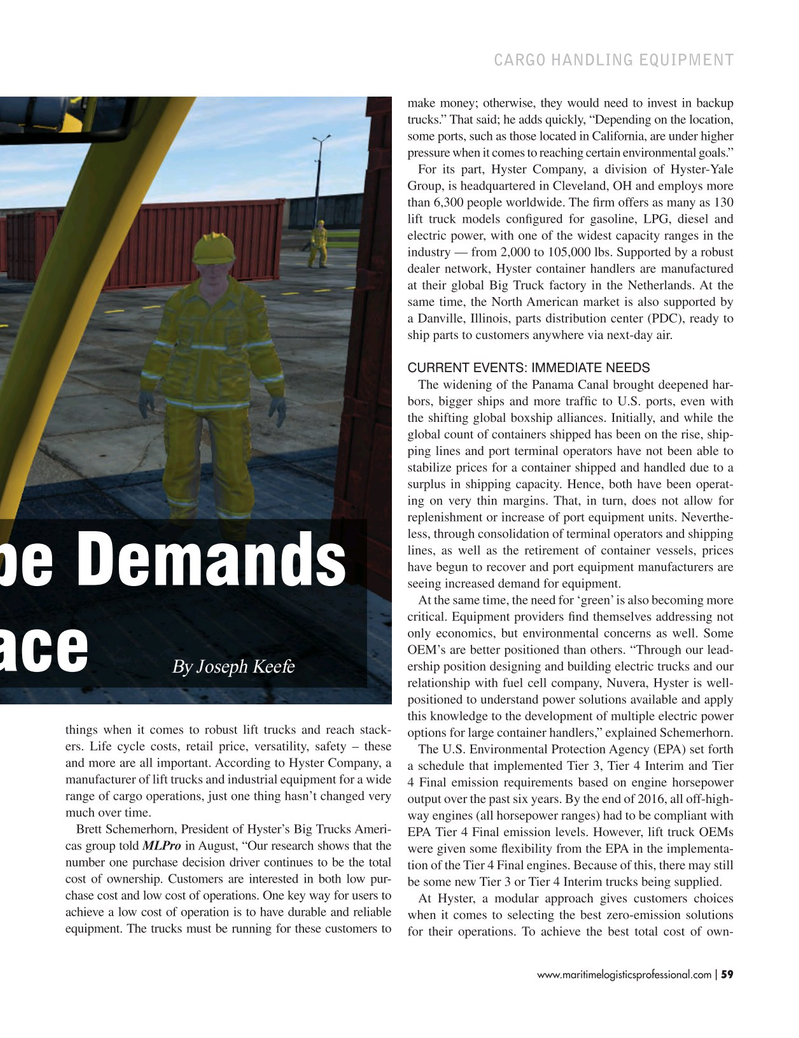
Page 59: of Maritime Logistics Professional Magazine (Jul/Aug 2017)
PORTS & INFRASTRUCTURE
Read this page in Pdf, Flash or Html5 edition of Jul/Aug 2017 Maritime Logistics Professional Magazine
CARGO HANDLING EQUIPMENT make money; otherwise, they would need to invest in backup trucks.” That said; he adds quickly, “Depending on the location, some ports, such as those located in California, are under higher pressure when it comes to reaching certain environmental goals.”
For its part, Hyster Company, a division of Hyster-Yale
Group, is headquartered in Cleveland, OH and employs more than 6,300 people worldwide. The frm offers as many as 130 lift truck models confgured for gasoline, LPG, diesel and electric power, with one of the widest capacity ranges in the industry — from 2,000 to 105,000 lbs. Supported by a robust dealer network, Hyster container handlers are manufactured at their global Big Truck factory in the Netherlands. At the same time, the North American market is also supported by a Danville, Illinois, parts distribution center (PDC), ready to ship parts to customers anywhere via next-day air.
CURRENT EVENTS: IMMEDIATE NEEDS
The widening of the Panama Canal brought deepened har- bors, bigger ships and more traffc to U.S. ports, even with the shifting global boxship alliances. Initially, and while the global count of containers shipped has been on the rise, ship- ping lines and port terminal operators have not been able to stabilize prices for a container shipped and handled due to a surplus in shipping capacity. Hence, both have been operat- ing on very thin margins. That, in turn, does not allow for replenishment or increase of port equipment units. Neverthe- less, through consolidation of terminal operators and shipping lines, as well as the retirement of container vessels, prices have begun to recover and port equipment manufacturers are
Changing Box Landscape Demands seeing increased demand for equipment.
At the same time, the need for ‘green’ is also becoming more critical. Equipment providers fnd themselves addressing not only economics, but environmental concerns as well. Some
OEM’s are better positioned than others. “Through our lead- ership position designing and building electric trucks and our
That Yard Tools Keep Pace
By Joseph Keefe relationship with fuel cell company, Nuvera, Hyster is well- positioned to understand power solutions available and apply this knowledge to the development of multiple electric power things when it comes to robust lift trucks and reach stack- options for large container handlers,” explained Schemerhorn.
ers. Life cycle costs, retail price, versatility, safety – these
The U.S. Environmental Protection Agency (EPA) set forth and more are all important. According to Hyster Company, a a schedule that implemented Tier 3, Tier 4 Interim and Tier manufacturer of lift trucks and industrial equipment for a wide 4 Final emission requirements based on engine horsepower range of cargo operations, just one thing hasn’t changed very output over the past six years. By the end of 2016, all off-high- much over time.
way engines (all horsepower ranges) had to be compliant with
Brett Schemerhorn, President of Hyster’s Big Trucks Ameri-
EPA Tier 4 Final emission levels. However, lift truck OEMs cas group told MLPro in August, “Our research shows that the were given some fexibility from the EPA in the implementa- number one purchase decision driver continues to be the total tion of the Tier 4 Final engines. Because of this, there may still cost of ownership. Customers are interested in both low pur- be some new Tier 3 or Tier 4 Interim trucks being supplied. chase cost and low cost of operations. One key way for users to
At Hyster, a modular approach gives customers choices achieve a low cost of operation is to have durable and reliable when it comes to selecting the best zero-emission solutions equipment. The trucks must be running for these customers to for their operations. To achieve the best total cost of own- www.maritimelogisticsprofessional.com 59
I

 58
58

 60
60
